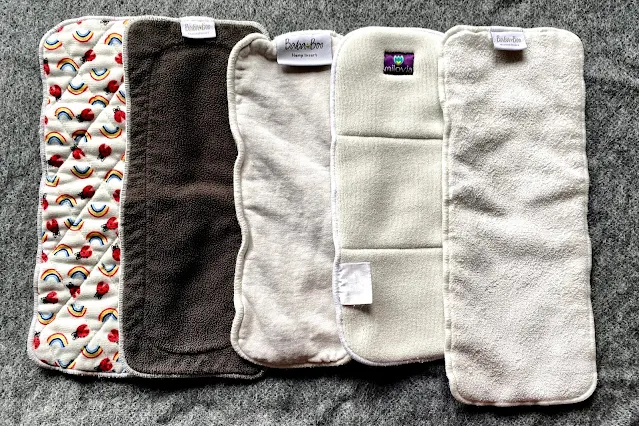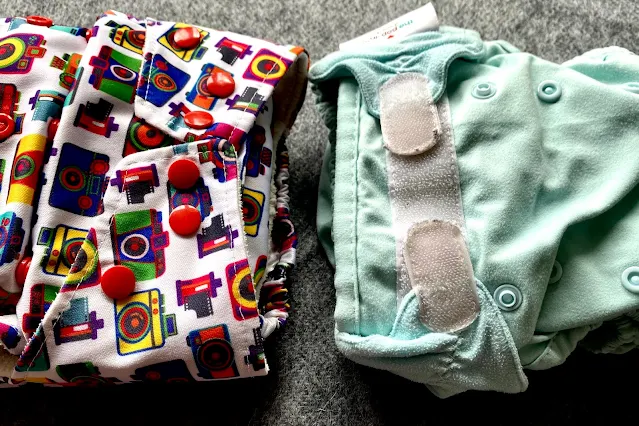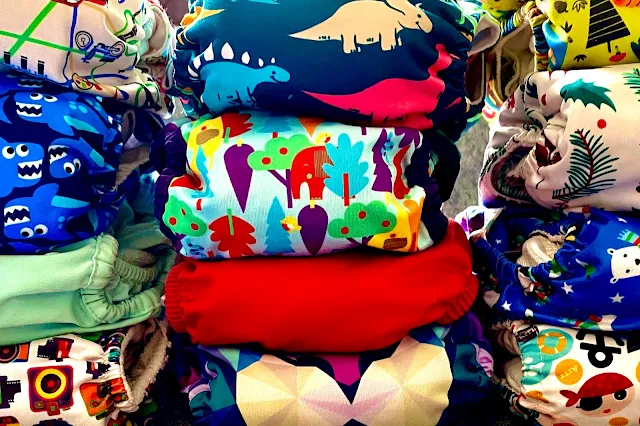You could say that it was a little late to start using cloth nappies when my 3rd child was 4 months old, but I have still saved money and avoided adding hundreds of nappies from landfill. I suspect my reason for turning to cloth is different to most peoples; it wasn't for eco reasons or because I like how they look, but because my son had a persistent case of nappy rash that wouldn't go away with disposables.
At the time I had just a handful of reusable nappies in my stash that I had bought for my second child in a Real Nappy Week impulse buy, but had hardly used. I tried using these on my son and found his nappy rash improved so I started to expand my collection.
At first I found a lot of the terminology around cloth nappies confusing. There were so many different options and when I looked online for answers I just got even more confused. Luckily we have a local cloth nappy library and the lady who runs it patiently answered all my questions.
I have been using cloth nappies for nearly 2 years now so I thought it’s time to share my wisdom so it can help someone else who is thinking about starting to use cloth nappies.
 |
| It can be confusing knowing how to get started with cloth nappies so I'm sharing what bamboozled me |
Understanding Cloth Reusable Nappies: Helpful Information To Get Started
All In Ones, All In Twos, Pop-Ins, say what?
Reusable nappies all work by having an absorbent part to soak up liquid and an outer waterproof layer to keep liquids from spreading any further (getting on clothes etc). Most modern cloth nappies come with both of these parts, but not all do (see the section on Covers below).
My favourites are pocket nappies which consist of a waterproof outer attached on 3 sides to a thin fleece liner forming a pocket. Inside this pocket you place the absorbent layer(s). There are lots of reasons I prefer these, including they dry quickly, but it’s mostly because you can stuff the pocket with a different amount of absorbent material depending on how long you are hoping to leave them for eg at bedtime you can stuff an extra in to see them through the night.
All In One nappies come with the absorbent part permanently attached to the waterproof part and with All In Twos the absorbent part attaches, often with poppers, to the waterproof bit, but can be taken off (eg for easier drying). As I mentioned them in the title, Pop-Ins at a type of All In Two nappy made by Close.
 |
| Putting a bamboo insert into a Baba & Boo pocket nappy |
 |
| A Close Pop-In All In Two nappy and a Bambino Mio Solo All In One nappy |
Covers? Wraps?
There are lots of different types of nappy, but one of the things that confused me most was covers or wraps. It turns out that there are some nappies (fitted nappies and flat nappies) that are just made from absorbent material and these need to be used with a second layer or cover to keep the wetness in. Most of the reusable nappies for sale now aren’t like that though so unless you are buying something like a Tots Bots Bamboozle your nappy will come with the both the waterproof and absorbent parts. Fitted nappies have a larger absorbent area so they are popular for night time, but they can be more expensive because you need to buy both parts separately.
Types of Insert
If you choose pocket nappies or a style of nappy that can accommodate boosters then you can add extra layers to increase absorbency and make them last longer between changes. These layers can be called different things like: insert, boosters, fillers or soakers and they are made from a wide variety of materials including towelling, bamboo and hemp. The different fabrics absorb different amounts of liquid at different speeds and also differ in how quickly they dry. I have quite a few different ones and choose a mix of them depending on need.
Most of the inserts are made from a mix of materials despite what the headline says so read the small print. The absorbency depends on the number of layers they are made from and the materials used, but generally hemp inserts are the most absorbent with bamboo and charcoal in the middle and microfibre being least absorbent, but it varies between brands.
You can start with the inserts your nappies come with and then buy more if you want. I bought some new and some second hand. Some of the cheaper nappies (like Alva Baby pocket nappies which are a great price and have awesome prints) don't come with great inserts, but it isn't really an issue as you can buy multipacks of more absorbent boosters to use them with.
 |
| There are lots of different types of inserts including bamboo, charcoal, hemp and microfibre (brands photographed are: Bambino Mio, Baba & Boo and Milovia |
Poppers or Velcro?
Long gone are the big metal safety pins holding nappies together (although some fitted and flat nappies mentioned above do require a clip). Most nappies now stay closed with poppers or velcro. Like so much of the choices around cloth nappies, what everyone prefers differs. Velcro can be quicker to get on and off, but I found my son was able to take them off himself from quite a young age so I switched to just using my popper ones which he finds harder to take off.
When washing nappies with velcro you need to remember to close them when in the wash to stop it catching on things and to stop the velcro getting fluffy. Poppers need to be undone carefully as they occasionally rip off the fabric which can make nappies unusable.
 |
| Poppers or Velcro closures are up to you (Baba & Boo on left and Close Pop-In on right) |
Liners
Liners were one of the things I couldn’t get my head round initially. You don’t have to use liners, but many people do, why? The first reason to use liners is because it makes poo easier to deal with. This doesn’t really make a difference until they start to eat food and have more solid poos, but the liner (when put carefully in place) catches the solids. This helps prevent the nappy getting stained and allows you to dispose of the poo more easily.
If using disposable liners you can throw the liner (and poo) away, if using reusable liners you can drop or scrape the poo into the toilet (sounds gross, but you quickly get used to it). Some disposable liners claim to be flushable, but much like flushable wipes they often aren’t great for the environment and can cause blockages. Liners aren’t just helpful for solids though. Fleece liners let wee pass through quickly and form a barrier against other layers of the nappy keeping skin nice and dry, this is especially useful in All In One and All In Two nappies (pocket nappies tend to have a fleece liner built in).
 |
| Liners are optional and you can use disposable or reusable (the fleece reusable ones pictured have been used hundreds of times now) |
What Size Cloth Nappies Should You Buy?
Some nappies, like fitted nappies, come in different sizes, but birth to potty nappies are the most economical choice for most people as the same nappy can be used for a child as they grow. They normally have poppers or velcro to adjust the size. While they can be used from birth they are pretty big for newborns so most people recommend using disposable nappies for the first 6 weeks or cloth in the newborn size. You can often get bundles of the newborn size nappies second hand for a good price and at great quality. Alternatively you could hire some from a nappy library.
Making Your Cloth Nappies More Absorbent
A helpful thing to know is that most cloth nappies need washing a few times before they reach their full absorbent potential. This is due to the manufacturing processes. If you only have a few nappies you can stick them in with your normal washing for these washes, just don't use fabric conditioner as that reduces absorbency.
Dealing With Dirty Nappies
Everybody will have their own approach and you'll find yours, but our system is now: scrape off any poo we can into the toilet with our “poo knife”. If you are lucky and your child is towards the more solid end of the poo spectrum you can just tip it into the toilet. Ours sadly tends not to be. We place soiled parts in a small wet bag and any nappies, pads, liners or wipes without poo go into a larger wet bag. They wait there until they need washing. You don’t need to separate the poo ones out, but I’ll explain why I do in a minute.
I have seen advice suggesting rinsing dirty nappies after use or to put them in a bucket of water until time for washing, but this will only make your life more complicated and gross. Keep them dry and contained. They are fine in a lidded bucket or wet bag for several days.
Washing Cloth Nappies
When our large wet bag is full it’s time to do washing and we tend to put a nappy wash on every 2 to 3 days. Now my son is older it’s quite a small amount of nappies that have poo on them so we keep these separate and put them in a quick wash on their own first (we have a 15 minute cycle). This gets rid of the worst of the poo so when it’s finished and we add the rest of the nappies into the mix they aren’t being washed in pooey water.
We use a 60 degree cycle for the full wash and add a small amount of washing liquid (and no fabric conditioner). Some purists say don’t use liquid detergent and recommend particular types of powder, I just use our normal detergent. Check your nappy brands instructions though, especially for temperature as some recommend washing at 30 or 40 degrees.
 |
| So many great prints, it can be hard to not buy more cloth nappies than you need! (Pictured include: TotsBots, Alva Baby, Close Parent, Baba & Boo, Bambino Mio and Milovia) |
Do your cloth nappies start to smell quickly when being worn?
We bought some secondhand inserts and after my son had worn them for an hour or so they started to really smell. After much Googling I discovered this was because they had a build up of detergent in which makes the nappies smell bad when mixed with wee. It’s important to not use too much detergent when washing nappies and to make sure they are rinsed well. I sometimes put the wash on extra rinse cycles if the machine looks really bubbly.
The second hand inserts were sorted after I washed them a few times with no detergent. You could tell there was a lot of build up by how bubbly those washes were. Afterwards they were much softer and more absorbent too. Google "strip washing nappies" if you are struggling with the smell of your nappies.
Drying Cloth Nappies
The best way to dry cloth nappies is outside in the sun. The sunshine will remove any stains (if the machine hasn’t), but in this country there is a limited window when this is possible. The rest of the year they need drying inside away from direct heat, or to be more accurate the waterproof parts of the nappy should be away from direct heat (no tumble drying, radiators or heated airers) because the waterproof lining can get damaged. If you have inserts that are not attached to the waterproof parts then you have much more flexibility in how these parts can be dried, including using a tumble dryer.
How to know when a cloth nappy needs changing
The one thing I have never found a good solution to is: knowing when a cloth nappy needs changing. With disposables the nappies gradually get bigger and bigger as they absorb more wee, that doesn’t happen with reusables. You basically have to guess based on the absorbent layers you have added and how much they have had to drink. If you leave it too long you will initially start to see signs of dampness on their clothes around where the nappy leg holes.
On a related point, one long time cloth user I spoke to said their children needed changing every few hours. With the pocket nappies stuffed with a mix of inserts ours lasts much longer than that and my son can go the whole night in a single nappy.
Dirty nappy storage when out and about
I have some small reusable wet bags which I put dirty nappies in when out. They are pretty good at stopping smells and they keep all the dirty bits inside. The bags can be washed with the nappies when dirty.
Is your cloth nappy leaking?
The main reason cloth nappies leak (other than they have soaked through after being left too long) is because they haven’t been put on very well. With disposables we would have leaks with every poo, but I didn’t get any when we started using reusables. I did sometimes when other people put reusables on because they often wouldn’t do them up tight enough. It’s particularly around the leg holes that need to be tightened, if you see a gap then pull the fabric round and see if it can be tightened some more.
You can get compression leaks with some materials: towelling for instance is more likely to release the wee it has absorbed if squeezed. Car seats or too tight vests can encourage this so think about when you seem to get leaks.
Boys can some times leak if they are pointing the wrong way, so be careful to arrange them properly when putting the nappy on.
If you find your nappies are leaking moisture in other areas than around the edges (eg leg holes and top of the nappy) then it might be that your waterproof lining is damaged. While it is apparently possible to reline them your best options may be to get rid of them or use them with a wrap (cover).
Am I glad we switched to Cloth nappies?
There are times I can’t be bothered with the washing (and I'll admit I have taken disposables on holiday with me) but overall I am so glad we use cloth nappies. I love that we don’t have to remember to buy nappies at the supermarket and that when the shelves were being stripped in the coronavirus panic we could confidently know we would be ok. Obviously knowing we weren’t sending a bin full of nappies to landfill every few weeks is a bonus too.
You get into a routine with washing quickly and it’s not too hard. It’s nice once you have build up your stash of nappies to not need to worry about spending any more money, although there are so many gorgeous designs I am often tempted.
Everyone differs in their preferences of styles and so it’s really worth trying a starter kit with different types before you commit to one style. These are often available for a value price or for hire. If you have any flexibility about when you buy it is worth checking for offers around Reusable or Real Nappy Week in April because most websites offer great discounts at this time.



















No comments
Thanks for your comment (unless it's spam in which case, why?)